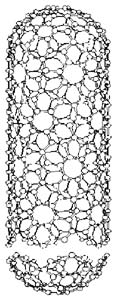Discussion Board | Supplemental Reading | Assignment
In Module 5, we will review nanofibers that are under investigation for tissue engineering and scaffold development. These nanofibers include:
- Electrospun Fibers
- Carbon Nanotubes
NANOFIBERS
Electrospun Fibers
Electrospinning or electrostatic fiber spinning employs electrostatic force to draw a fiber from a spinneret. This fiber solidifies and lies down on a collector in the form of a non-woven fiber mat.
Electrospun nanofiber structures, using natural or synthetic biodegradable polymers, have drawn increased interest for use as scaffolds for tissue engineering. Electrospun nonwoven webs containing sub-micron diameter fibers serve as near ideal substrates to grow soft tissues in that they provide a unique structure characterized by a high surface area to volume ratio and three-dimensional interconnected pore network, both of which enhance cell attachment and proliferation.

Electrospinning technique makes it possible to generate structures that resemble native extra-cellular matrix (ECM) elements. Cell -culture studies on such structures have demonstrated that the scaffolds become densely populated with cells in a short time and they promote cellular infiltration into the fibrillar network. It has also been shown that the cell adhesion and proliferation rate significantly improves on nanofibrous scaffolds as compared to plane porous polymer films.
Natural and synthetic polymers are used for scaffold applications. Natural polymers are preferred since they are inherently capable of binding cells since they carry specific protein sequences, such as RGD (arginine/ glycine/ aspartic acid). Synthetic biodegradable polymers provide the necessary mechanical properties, such as viscoelasticity and strength, and their degradation rate can be controlled as needed. Therefore, there is merit in combining natural and synthetic polymers to produce materials that have novel hybrid properties at the sub-micron level. Such composite structures using different combinations of polymers may prove to be valuable for a variety of other applications as well, such as for drug delivery, optical fiber, and circuit board nanocables systems.
Carbon Nanotubes
Carbon nanotubes are molecular-scale tubes of graphitic carbon with outstanding properties. They are among the stiffest and strongest fibers known (about 10,000 times thinner than a human hair), and have remarkable electronic properties and many other unique characteristics. The uniqueness of the nanotube arises from its structure and the inherent subtlety in the structure, which is the helicity in the arrangement of the carbon atoms in hexagonal arrays on their surface honeycomb lattices. The helicity (local symmetry), along with the diameter (which determines the size of the repeating structural unit) introduces significant changes in the electronic density of states, and hence provides a unique electronic character for the nanotubes.

Nanotubes can be found in several forms; single-wall (having one single shell), double-wall and multi-wall. Depending on the growth process, single-wall, double-wall or multi-wall nanotubes can be selectively produced.

The nature of the bonding of a nanotube is described by applied quantum chemistry, specifically, orbital hybridization. The chemical bonding of nanotubes is composed entirely of sp2 bonds, similar to those of graphite. This bonding structure, which is stronger than the sp3 bonds found in diamonds, provides the molecules with their unique strength. Nanotubes naturally align themselves into “ropes” held together by Van der Waals forces. Under high pressure, nanotubes can merge together, trading some sp² bonds for sp³ bonds, giving the possibility of producing strong, unlimited-length wires through high-pressure nanotube linking.
Nanotubes have unique properties for tissue engineering- mechanical and electrical. These tubes are mainly investigated as composite structures for tissues. They exhibit excellent control matrix mechanical properties, and are able to modulate matrix electrical properties. Nanotubes also stimulate the phenotypic development of cells by modulating scaffold conductivity and modulating an applied electrical field, and mimic neural fibers for neuronal growth. In addition, they exhibit electrical conductivity for directed cell growth.

Challenges faced include the presence of contaminants, difficulty in reproducing surface chemistry, their minimal solubility in water (due to the lack of charge separation), and the tendency to aggregate within hydrophobic regions of lipid bilayer to form focal points.
SUPPLEMENTAL READING
This article gives a brief overview on the current development and application status of employing electrospun composite nanofi bers for constructing biomimetic and bioactive tissue scaffolds.
This supplemental reading reviews the current status of available methodologies for the aqueous dispersion and solubilization of carbon nanotubes, discuss the results on modifications of carbon nanotubes with various biological and bioactive species, and highlight some of the recent achievements in the fabrication and evaluation of carbon nanotube-based bioanalytical devices.


